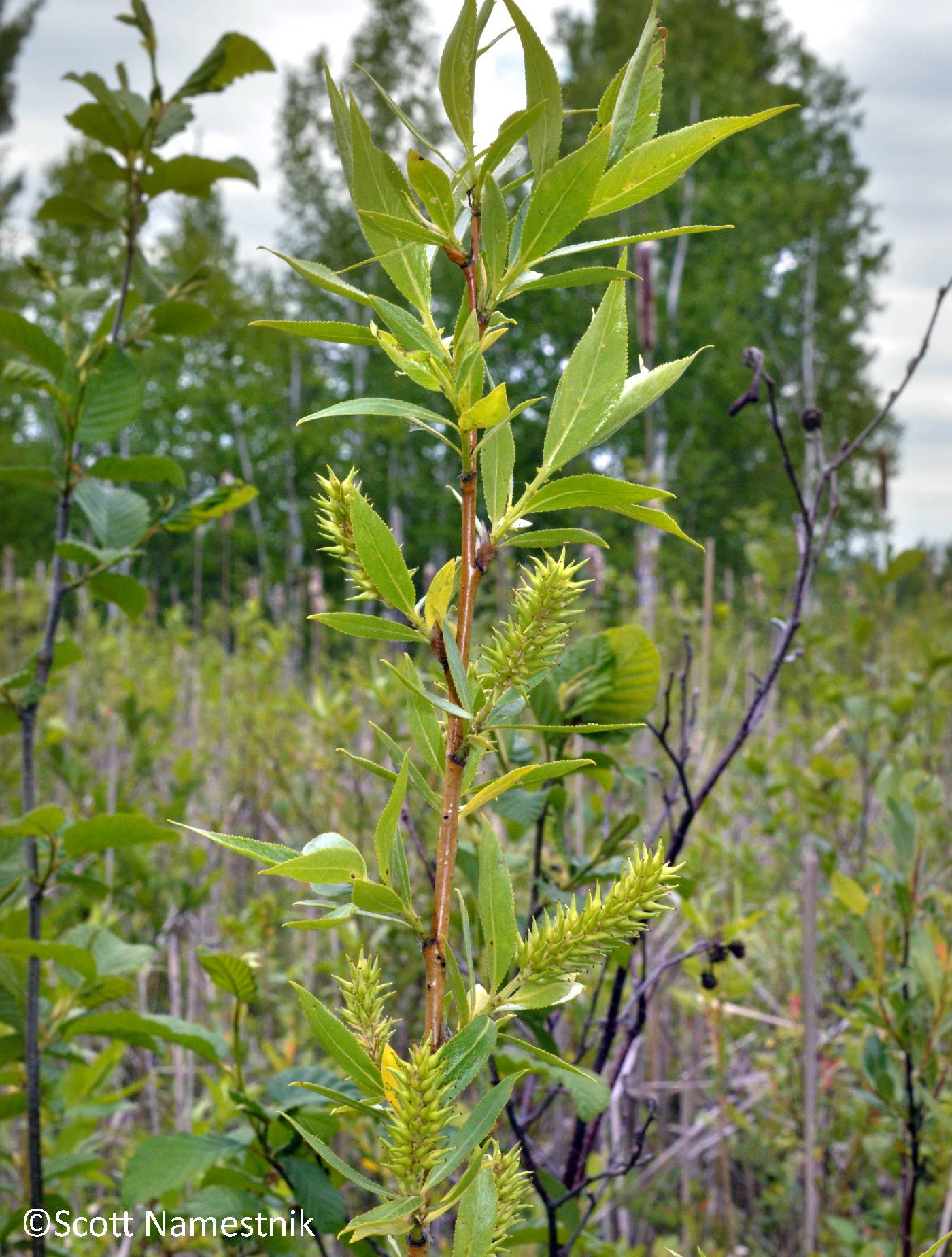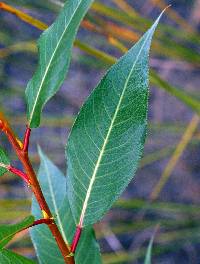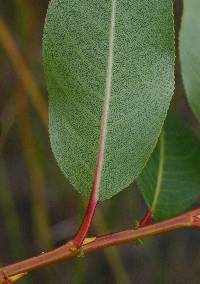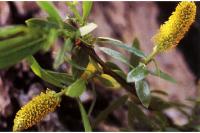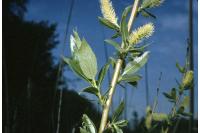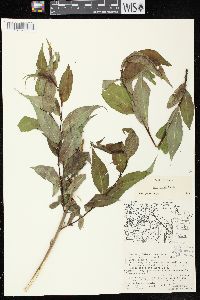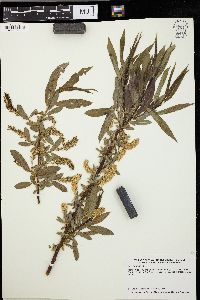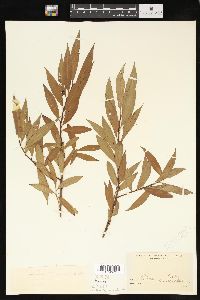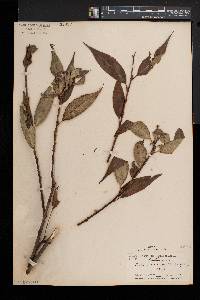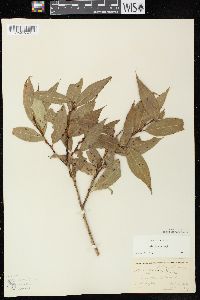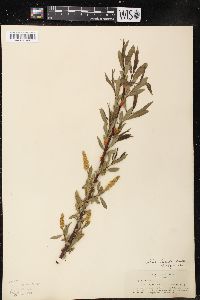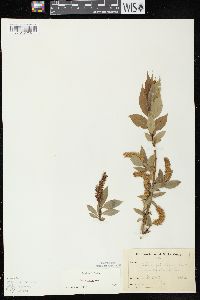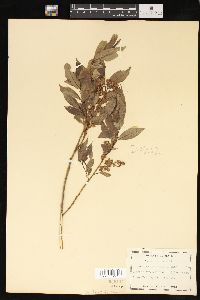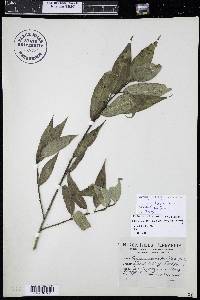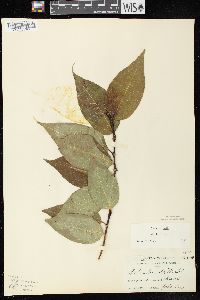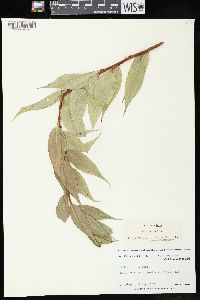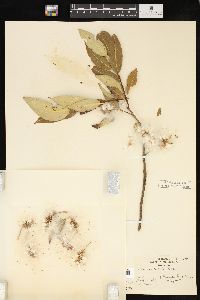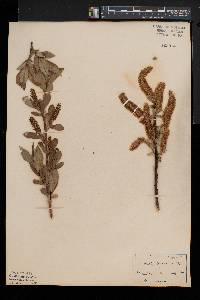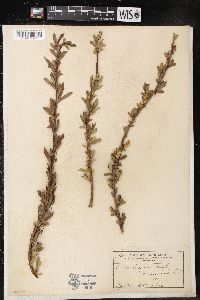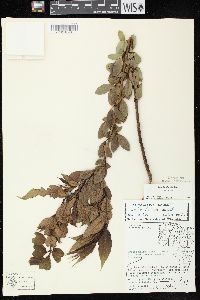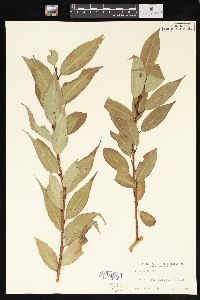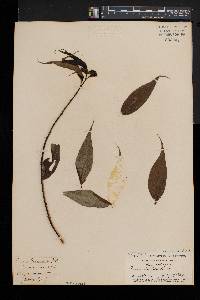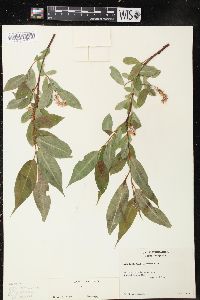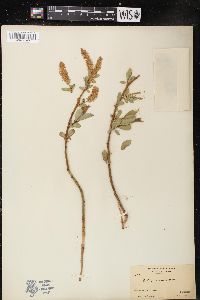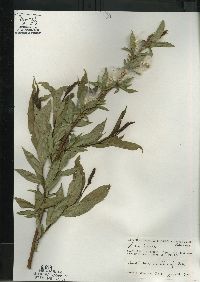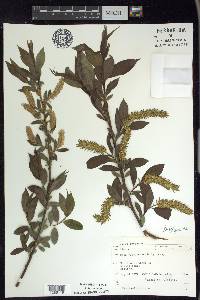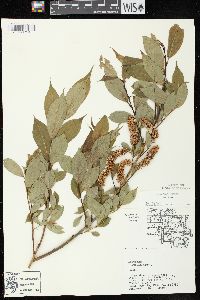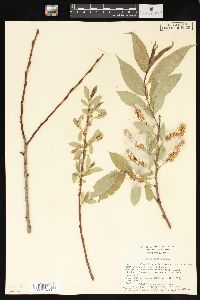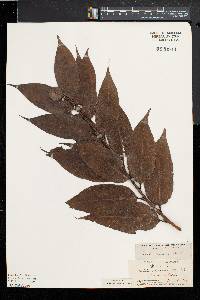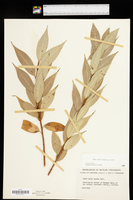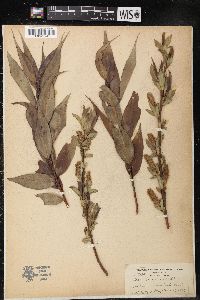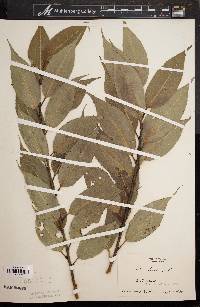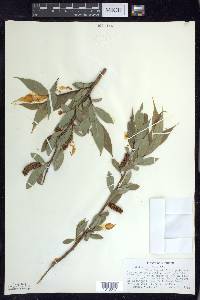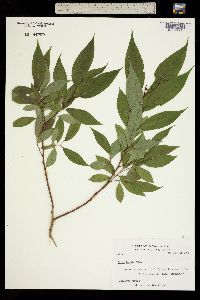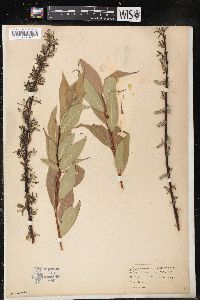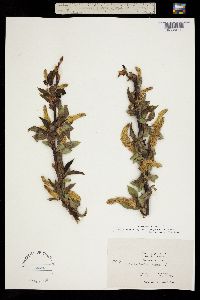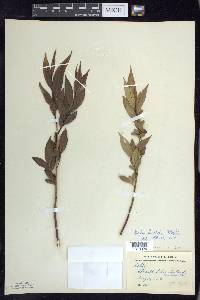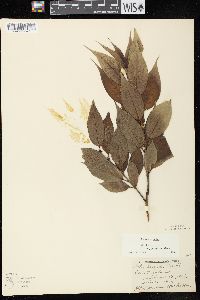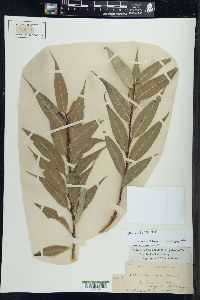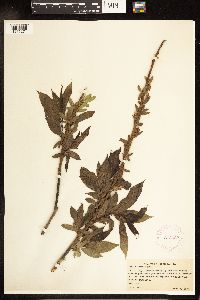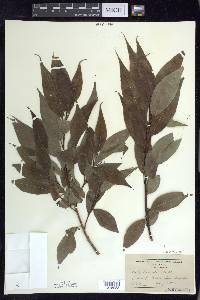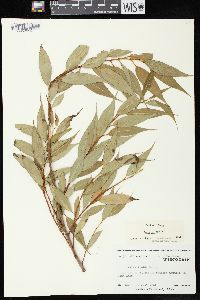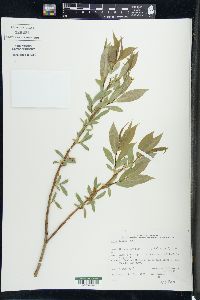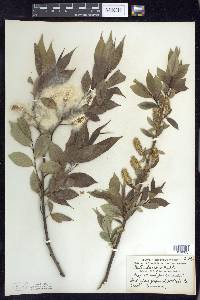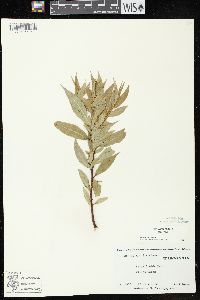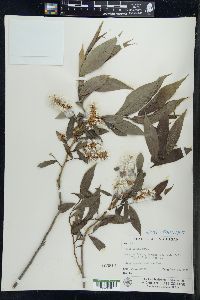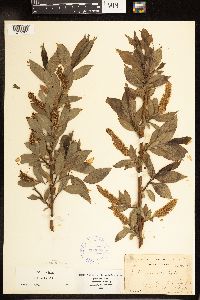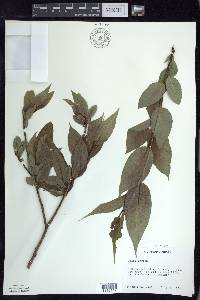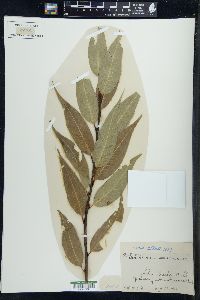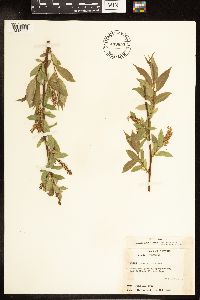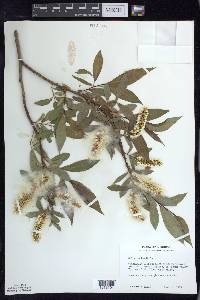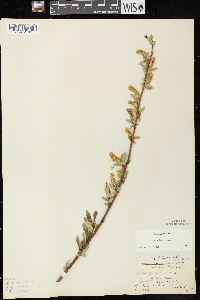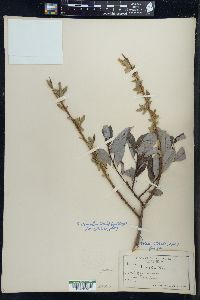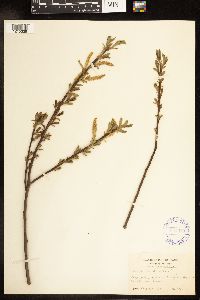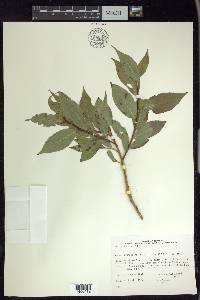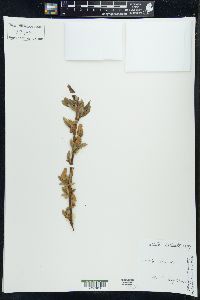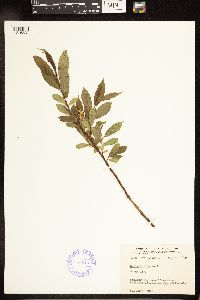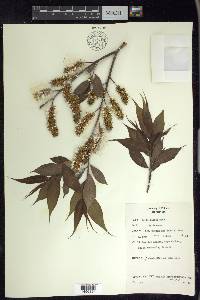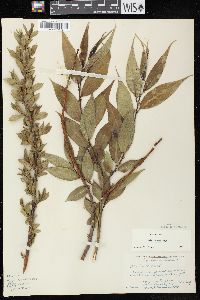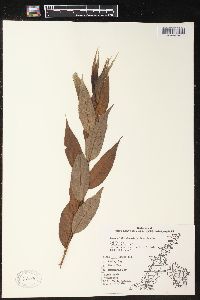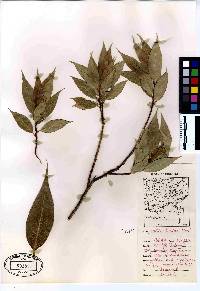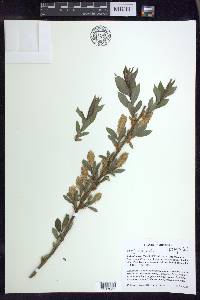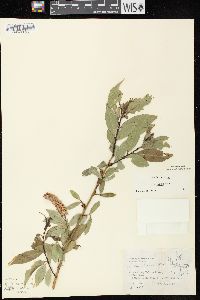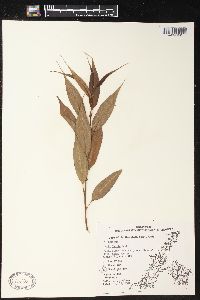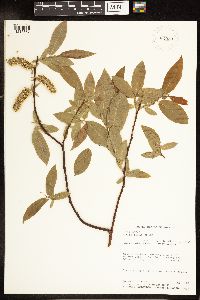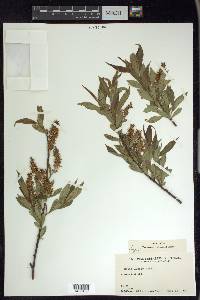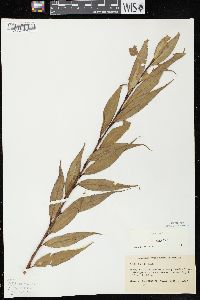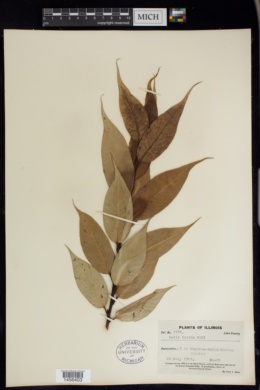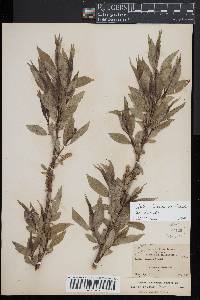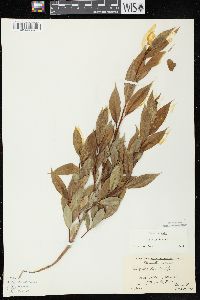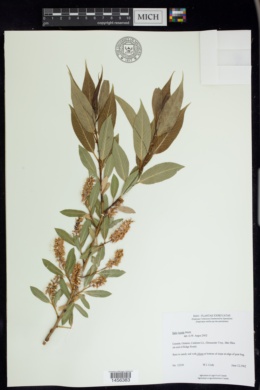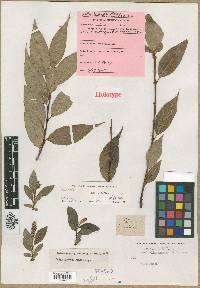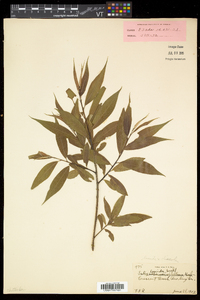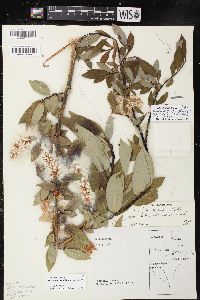
|
|
|
|
Family: Salicaceae
Shining Willow
|
Shrubs or trees, 4-6 m. Stems: branches flexible to highly brittle at base, yellow-brown, gray-brown, or red-brown, slightly to highly glossy, glabrous or villous to glabrescent; branchlets yellow-brown, gray-brown, or red-brown, glabrous, pilose, densely villous, or velvety, hairs spreading, straight, wavy, or crinkled. Leaves: stipules foliaceous, apex convex to rounded; petiole shallowly to deeply grooved adaxially, 5-13 mm, with clusters of spherical or foliaceous glands distally, glabrous, pilose, or densely villous adaxially; largest medial blade usually hypostomatous or hemiamphistomatous, rarely amphistomatous, lorate, very narrowly elliptic, narrowly elliptic, or lanceolate, (24-)55-133 × 11-43 mm, 2.5-6.2 times as long as wide, base convex or cuneate, margins flat, serrulate, apex acuminate to caudate, abaxial surface usually not glaucous (rarely so), glabrous, pilose, or moderately densely villous or long-silky, hairs appressed or spreading, white and/or ferruginous, straight or wavy, (coarse, caducous), adaxial (secondary veins flat or protruding), slightly or highly glossy, glabrous, pilose, or long-silky, hairs white and/or ferruginous; proximal blade margins entire and glandular-dotted, or serrulate or crenulate; juvenile blade reddish or yellowish green, glabrous or densely villous or long-silky abaxially, hairs white and ferruginous. Catkins: staminate 19-69 × 4-14 mm, flowering branchlet 5-23 mm; pistillate (fruiting in summer), moderately densely to loosely flowered, slender to stout, 23-56(-70 in fruit) × 8-12 mm, flowering branchlet 8-25 mm; floral bract 1.5-3 mm, apex convex or rounded, entire or toothed, abaxially sparsely hairy throughout or proximally, hairs wavy. Staminate flowers: abaxial nectary 0.5-1.1 mm, adaxial nectary square or ovate, 0.3-0.9 mm, nectaries connate and cup-shaped; stamens 3-6; filaments distinct, hairy on proximal 1/2 or basally; anthers ellipsoid, shortly cylindrical, obovoid, or globose, 0.6-0.8 mm. Pistillate flowers: adaxial nectary square or ovate, (swollen), 0.2-0.5 mm, shorter than stipe; stipe 0.5-2 mm; ovary pyriform, beak slightly bulged below or gradually tapering to styles; ovules 18-24 per ovary; styles connate or distinct 1/2 their lengths, 0.5-0.8 mm; stigmas flat, abaxially non-papillate with rounded tip, broadly cylindrical, or 2 plump lobes, 0.24-0.31-0.42 mm. Capsules 5-7 mm. 2n = 76. Flowering early May-mid Jul. Sandy or gravelly floodplains, lake margins, sedge meadows, vernal pools, alvars, open fens, marl bogs, treed bogs; 0-600 m; St. Pierre and Miquelon; Man., N.B., Nfld. and Labr., N.S., Ont., P.E.I., Que., Sask.; Conn., Del., Ill., Ind., Iowa, Maine, Md., Mass., Mich., Minn., N.H., N.J., N.Y., N.Dak., Ohio, Pa., R.I., S.Dak., Vt., Va., W.Va., Wis. The Virginia plants of Salix lucida are introduced (G. W. Argus 1986). The Salix lucida complex is a group of three weakly delimited taxa, S. lasiandra var. caudata, S. lasiandra var. lasiandra, and S. lucida. The morphological characters used to separate them (leaves amphistomatous or hypostomatous and blades glaucous abaxially or not) are usually geographically correlated, but there are exceptions. G. W. Argus (1986b) proposed, based on principal components analysis of morphological data, to treat them as a single species consisting of three subspecies. The geographic overlap of the northeastern S. lucida and the western S. lasiandra is a relatively small area in central Saskatchewan. Evidence of intergradation was based on cultivation of a plant that, in the wild, had leaves that were not glaucous abaxially but were glaucous in cultivation. It seems best to treat them as two species, S. lucida and S. lasiandra, the latter with two varieties, var. lasiandra and var. caudata. Hybrids: Salix lucida forms natural hybrids with S. alba and S. nigra. Hybrids with S. serissima have been reported (M. L. Fernald 1950) but no convincing specimens have been seen. Attempts to hybridize S. lucida with members of subg. Protitea (S. amygdaloides), subg. Longifoliae (S. interior), and subg. Vetrix (S. discolor, S. eriocephala, and S. petiolaris) were unsuccessful (A. Mosseler 1990). Salix lucida × S. nigra (S. ×schneideri B. Boivin) seems to be a rare intersubgeneric hybrid between tetraploid S. lucida and diploid S. nigra. It is known only from the type specimen, an infertile plant, growing with both parents. It resembles S. lucida in bud-scale margins connate, in petiolar glands stalked or foliaceous, and in leaf shape, and S. nigra in stipules rudimentary on proximal leaves and sometimes even on early leaves, stipule apex acute, pistillate catkins relatively long and slender, and styles relatively short.
Plant: shrub or tree; to 11 m tall; branches flexible or brittle at base, branches and branchlets yellow-, gray-, or red-brown; branchlets glabrous, pilose, or villous becoming glabrous Leaves: stipules strongly glandular; petioles glabrous or pilose, gland-dotted or lobed at base of blade, 13-30 mm long; proximal leaves on vegetative or flowering branchlets gland-dotted or serrulate; young leaves glabrous, villous, or silky; mature blade narrowly oblong, very narrowly elliptic to lanceolate, or oblanceolate, 24-170 mm long, 9-43 mm wide, 2.5-9.8 times as long as wide, the lower leaf surface glaucous or not, glabrous, pilose, or silky becoming glabrous, the hairs white, or white and rust-colored; upper surface glossy, glabrous, pilose or silky becoming glabrous; base acute, rounded, or obtuse, the margins flat, serrulate, with 6-14 teeth per cm, the apex caudate to acuminate INFLORESCENCE: cylindrical to subspherical catkins; coetaneous; floral bracts tawny, 1.5-4 mm long, glabrous to wavy hairy, the apices rounded, entire, toothed, or erose; pistillate floral bracts deciduous after flowering Flowers: STAMINATE FLOWERS in densely flowered catkins 17-50 mm long; flowering branchlets 8-25 mm long; stamens more than 3; filaments hairy at base only; nectaries 1 abaxial and 1 adaxial, square or ovate, 0.3-0.5 mm long. PISTILLATE FLOWERS in densely to moderately flowered catkins 20-100 mm long; flowering branchlets 6-65 mm long; ovaries glabrous; stigmas 0.16-0.42 mm long; styles 0.2-0.8 mm long; stipes 0.5-4 mm long; nectary square or half-cup-shaped, 0.2-0.5 mm long, shorter than stipes Fruit: lanceolate to ovate REFERENCES: Argus, George W. 1995. SalicaceaePart 2. Salix. J. Ariz. - Nev. Acad. Sci. 29(1): 39 Shrub or small tree to 8 m tall, trunk diameter 15 - 20 cm Leaves: alternate, on 5 - 10 mm long, glandular leafstalks, dark yellowish green above, paler beneath, 5 - 13 cm long, 1.2 - 3.7 cm wide, egg-shaped to lance-shaped with a rounded to tapering base and long-pointed tip (broadest just below the middle), finely gland-toothed, and shiny on both sides. Flowers: either male or female, borne on separate trees (dioecious) in cylindrical catkins. The catkin is slightly hairy and grows on a short, leafy stalk. Female catkin greenish with yellow scales, 6 - 8 cm long. Male catkin 3 - 5 cm long, with yellow scales. Stamens three to six. Filaments hairy to the middle. Anthers yellow. Fruit: a capsule, in elongated clusters, stalked, brown, 5 - 7 mm long, and flask-shaped. Seeds have long, white, silky hairs attached. Twigs: dark orange to chestnut brown, shiny, becoming darker with age. Buds: chestnut brown, blunt, and shiny. Form: broad and rounded with short trunks and ascending branches. Similar species: In the Chicago Region, Salix lucida differs from most other willows by having finely toothed leaves that are shiny green, hairless, and not revolute (rolled downward along the margins). Salix serissima, which is similar, has waxy and less shiny lower leaf surfaces. Another similar species, S. pentandra, has elliptical to egg-shaped leaves that are typically wider than S. lucida. Flowering: May, with the leaves Habitat and ecology: Local in boggy sites, and locally common in the great marsh area of the dune region. Also found in recently disturbed, moist sandy areas. Occurence in the Chicago region: native Notes: Salix lucida is often planted as an ornamental. It is also planted to prevent stream bank erosion. The wood is of no commercial value. Etymology: Salix is the Latin word for willow. Lucida means bright, clear, or shining. Author: The Morton Arboretum Shrub or small tree to 6 m; bark brown, smooth; twigs and young lvs usually with caducous, reddish-brown hairs, otherwise glabrous, the twigs and buds shining, chestnut-brown; buds blunt, the scale with fused margins (as in spp. 5-30); stipules well developed and persistent, 2-5 mm, reniform to semilunate, glandular along the margin; lvs lanceolate to lance-ovate, 5-15 נ1.5-4 cm, 3-5 times as long as wide, mostly abruptly long-acuminate or attenuate, sharply glandular-serrate, shining green above, paler green beneath; petioles 5-15 mm, glandular at the tip; catkins with the lvs, 2-5 cm, on lateral leafy peduncles 1-2.5 cm, the scales yellow, thinly hairy, deciduous; stamens 3-6; fr lanceolate, 4.5-7 mm, glabrous; pedicels 0.5-1 mm; style 0.5-0.8 mm; 2n=76. Moist or wet low ground; Nf. and Lab. to Sask., s. to Del., W.Va., Io., and Nebr.; Roanoke Co., Va. Plants with the twigs and lower lf-surfaces ±persistently hairy are occasionally found in the n. part of our range (var. intonsa Fernald). A hybrid with no. 7 [Salix alba L.is S. تesupii Fernald. Gleason, Henry A. & Cronquist, Arthur J. 1991. Manual of vascular plants of northeastern United States and adjacent Canada. lxxv + 910 pp. ©The New York Botanical Garden. All rights reserved. Used by permission. From Flora of Indiana (1940) by Charles C. Deam An infrequent willow in the lake area about lakes, along streams, and in swamps and marshes. [The leaves of variety intonsa are more permanently pubescent beneath with reddish hairs.] This shrub is 4-12 feet high; found locally in the lake area about lakes, along streams, and in swamps and marshes. Not as frequent. …… Indiana Coefficient of Conservatism: C = 10 Wetland Indicator Status: FACW |

